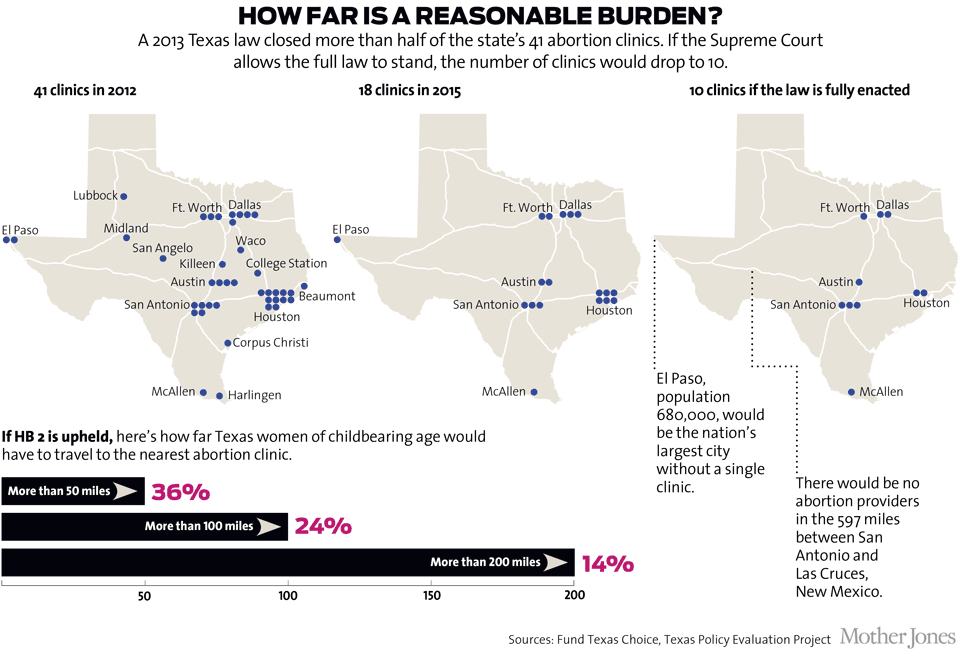The pro-life movement went through a reinvention, it was once known as a violent, poorly organized group of people who protested clinics and doctors and in some cases killed doctors. Now, the movement is well funded, organized and making great headway through small incremental legal decisions requiring more and more of abortion providers. Requirements range from having one bathroom for every six patients, having access to nitrous oxide and compressed air, which are never used in first-term abortions, requiring women print and read information 24 hours (time stamp required) before their procedure — which is difficult for poor women without access to computers, and so forth. The new guidelines requiring abortions be performed in surgical centers, something the pro-life forces call prudent, yet is deemed unnecessary by the American College of Obstetricians and Gynecologists, as no surgery is taking place in a first trimester abortion are ways to make abortions cost prohibitive to the patient and to the clinics.
These new requirements are running clinics out of town and making it harder and harder for women to have safe abortions. The Supreme Court will decide if it will hear a case on whether a women’s limited access to the diminishing number of abortion clinics in the United States presents an “undue burden” to her legal right to access protected by the 1971 decision Roe v. Wade. The clock has been turned by back on a woman’s right to a safe abortion, in a death by a thousand cuts kind of way.
Here are excerpts from the piece. This is well worth the whole read to really understand what’s been happening and how dramatically the landscape has changed in the last decade.
This is what 2015 looks like: Abortion providers struggle against overwhelming odds to stay open, while women “turn themselves into pretzels” to get to them, as one researcher put it. Activists have been calling it the “war on women.” But the onslaught of new abortion restrictions has been so successful, so strategically designed, and so well coordinated that the war in many places has essentially been lost.
Most abortions today involve some combination of endless wait, interminable journey, military-level coordination, and lots of money. Roe v. Wade was supposed to put an end to women crossing state lines for their abortions. But while reporting this story, I learned of women who drove from Kentucky to New Jersey, or flew from Texas to Washington, DC, because it was the only way they could have the procedure. Even where laws can’t quite make it impossible for abortion clinics to stay open—they are closing down at a rate of 1.5 every single week—they can make it exhausting to operate one. In every corner of America, four years of unrelenting assaults on reproductive rights have transformed all facets of giving an abortion or getting one—possibly for good.
******

In Texas:
One portion of the bill—known as HB 2—required all abortions to take place in what amounts to a mini-hospital. Another section required clinics to make administrative pacts with local ERs, which wiped out clinics in areas where all the hospitals are Baptist or Catholic, or susceptible to political pressure.
Before the measure, Texas had 41 clinics. Within four months, there were only 22; today, there are 18. As different sections of the law clicked into place, every clinic west of San Antonio closed down but one—there used to be five—leaving a swath of Texas 550 miles wide without a single abortion provider.
HB 2 was not the only assault on providers. In College Station, the site of Texas’ largest university, a Planned Parenthood clinic, felled by dramatic cuts to the state’s family planning budget, has been replaced by a crisis pregnancy center, a pro-life clinic where women are told scientifically debunked claims about supposed links between abortion and breast cancer or thoughts of suicide.
Whole Woman’s Health operates four clinics in Texas. But if HB 2 is fully enforced, which means that abortions could only take place in hospital-like clinics, just one of those clinics would remain open. Miller wasn’t willing to concede the fight. Instead, Whole Woman’s Health sued the state, claiming that the distances women would be forced to travel constitute an “undue burden”—the legal standard the Supreme Court established in 1992 for striking down an abortion restriction.
Miller won in district court, but lost when the state took the case to the 5th Circuit Court of Appeals. In June, the US Supreme Court put the 5th Circuit’s decision on hold—for the time being, all 18 clinics remain open pending the high court’s decision in the fall as to whether it will hear the case. Because the lawsuit offers the court a chance to clarify the definition of “undue burden,” it could be the most important—or detrimental—decision on abortion rights in two decades. If Miller loses, Texas will be free to shut down all but 10 clinics.
*****
While Texas has been the epicenter of the debate over abortion access, the broader story goes far beyond its borders. In many ways, the successes of abortion opponents could read like a real-life example of what political strategists call “moving the Overton Window,” or shifting the parameters on what are publicly—and therefore politically—acceptable options between two extremes. As this political theory goes, apply the right pressures, and over time the window can shift and radical ideas can become mainstream. Many abortion opponents have abandoned violent protests and clinic bombings to push for restrictions that purport to be about informed consent (waiting periods) or safety (surgical facilities).
Because AUL’s measures seem reasonable, not only can legislators from red districts use them to rally the base, but those from purple districts can get behind them without facing a backlash. But the effects of these seemingly moderate and sensible abortion restrictions have, in fact, been breathtakingly radical.
A clinic called the Cherry Hill Women’s Center in southern New Jersey is seeing more and more patients from Virginia—they travel that far because clinics in Maryland and Delaware are overbooked—and the Midwest, where many clinics have shut down. Ohio has closed 7 of 16 clinics since 2011. Women from Ohio and Indiana have increasingly crossed state lines to go to Chelian’s clinics in Michigan.
In many states, women also have to plan their long journeys around an obstacle course of abortion restrictions. Thirteen states, including Texas, have introduced laws that require women to make an extra clinic visit—usually for anti-abortion counseling—24, 48, or even 72 hours before they can get the procedure. Sarah Roberts, a researcher with a project called Advancing New Standards in Reproductive Health at the University of California-San Francisco, found that Utah’s three-day waiting period caused the average woman to delay her abortion eight days. The delay cost women money (in Texas, women who pay out-of-pocket spend an average of $141 on these extra visits) and forced them to have to tell more people about their abortions. Roberts met one woman who couldn’t get an abortion because the delay prolonged her pregnancy to the second trimester.
Fewer abortion clinics also means longer waits, which can mean a more complicated and expensive procedure. In the past year, the TEA Fund has helped 402 women pay for abortions but was asked for help by an additional 2,569. It had to double the average amount of money it spends per patient from $100 to $200.
“You really only get to give people good news for maybe the first couple hours of your shift,” says Desirae Embree, a graduate student at Texas A&M University who volunteers for the fund. “From then on, you’re probably going to be calling people who are desperate and need help to tell them that there’s no more money left, and they need to try again.”
Jo Wunderlich, who also volunteers at the TEA Fund, recently took a call from a young woman who’d just sold her car to pay her rent. To raise money for her abortion, she pawned her TV. The TEA Fund gave her $200, the maximum Wunderlich was authorized to give, but she was still several hundred dollars short. “I know she’ll be fine,” Wunderlich said, as much to herself as to me. “She’s in her first trimester. She still has time to raise the money.”
****
By contrast, the “ambulatory surgical center” (ASC) where Texas wants to abortions to take place is a hulking facility intended for outpatient surgery. There are strict square footage standards and requirements for pricey equipment—like scrub sinks and air filtration systems—that doctors simply don’t need for first-trimester abortions. In some cases, it costs providers about 40 percent more in utilities and property taxes to run an ASC. That is, if they can raise the funds—several million dollars—to build them. In addition to Texas, 24 other states have passed legislation to require many abortions to be performed in such facilities, although litigation is pending in two of those states.
“It really changes the nature of the practice,” said Carole Joffe, who has studied abortion providers for decades through the UC-San Francisco project. “Beyond the financial demands of what ASCs mean,” she said, “what these restrictions have done—and it’s so cruel—is they’ve struck at the heart of how good abortion care has been visualized for so long.”
The laws requiring abortions to take place in ASCs are not intended to shutter abortion clinics, abortion foes insist. Abortion should simply be treated like other surgical procedures, says AUL’s Kristi Hamrick. “The states themselves have a standard for locations that want to engage in some kind of surgical procedure,” she says. “The abortion industry is acting like somehow the pro-life movement went out with a tape measure to create these standards. It’s not AUL that’s dictating the size of the hallways.”
But mainstream medical groups are unequivocal that the vast majority of abortions do not require such precautions. Ninety percent of abortions take place in the first trimester. The procedure is typically performed while the woman is under mild sedation or awake and under local anesthesia. The doctor places a speculum in the vagina, dilates the cervix, and uses a suction device—which can be electrical or as simple as a small plastic syringe—to remove the pregnancy from the uterus. Afterward, most women spend an hour or so with a heating pad to ease cramps before going home. Complication rates are incredibly low; abortion is 40 times safer than a colonoscopy. Many abortion providers willingly operate surgical facilities so they can perform more complicated abortions, which are more likely to arise in the second trimester.* But the American College of Obstetricians and Gynecologists has reviewed decades of evidence and determined that most abortions are safe to perform in a properly equipped doctor’s office.
****
Hart clicks through the door of an operating theater. It’s about the size of a starter apartment, and it’s slightly cozier than a meat locker. Planned Parenthood wanted to decorate the barren white walls with art. But ASC rules about dust control caused staff to reconsider. Above us, a set of cryptic-looking nozzles, for pumping nitrous oxide and compressed air, jut out from the ceiling like high-tech stalactites. “It’s frightening, isn’t it?” Hart says. “And there’s just no reason for that.” None of them have hoses attached; the doctors don’t need what they pump. At the nurses’ station, a row of blinking orange lights alerts us that the supplies are low.
“In my clinics, staff have scrubs on, but they can hold a patient’s hand,” Miller told me. “They can wipe away her tears.” Women wait for their turn in a reception area, she added, and they wear their own clothes. But in surgical centers like this one, all the patients are naked beneath their hospital gowns. “There’s no individuality.” Nurses disappear beneath bonnets and booties and surgical masks. Clinics can’t use heating pads any more, because they might harbor bacteria. These are appropriate safety measures for facilities where surgeons cut people open—but that’s not what happens in a first-trimester abortion.
*****
But the fight is not over. Abortion foes have also legislated the dosage of medication a woman may take. Typically, doctors now prescribe 200 milligrams of Mifeprex and 800 micrograms of misoprostol. That’s different from the amounts the Food and Drug Administration originally approved when RU-486 first arrived on the scene in 2000. And while such tweaking is common in medicine as new evidence accumulates, five states (Iowa is not one of them) have now passed laws requiring doctors to prescribe abortion pills according to the original, outdated FDA guidelines.
Those older dosages make the medication harder to tolerate—failure rates more than double, and almost every woman experiences at least one severe side effect like nausea, vomiting, or cramps. Many abortion providers simply refuse to prescribe abortion drugs under these rules. I found only one provider, David Burkons of Cuyahoga Falls, Ohio, who uses the old dosages and was willing to talk about it on the record. “I explain it to patients. I explain there could be these effects,” said Burkons, not a little defensively. “And still, there are people who, this is what they want to do.” The whole thing requires four trips to his office: Once to hear Burkons read a script describing the fetus, which is required by the state, once for each dose, because the old guidelines prevent them from taking the second dose at home, and a fourth time for a follow-up. Women often bleed after the second dose—only now it’s in their cars instead of at home. Because the old rules require a higher dose, the procedure currently costs an extra $160.
And it gets more Kafkaesque: Since Burkons started prescribing abortion pills under the rules promoted by abortion opponents, he has reported 17 instances of patient complications to the state health department. Almost all of those women had experienced incomplete abortions—an inevitable outcome when using the outdated dosage. Operation Rescue, an anti-abortion group, got hold of those reports and splashed them across its website. “His dangerous abortion operation should be closed permanently,” said Troy Newman, the group’s president, “in order to protect women.”
The extra time and money involved has skewed the patient population toward women who are white, educated, and insured, says Ushma Upadhyay, a researcher for the UC-San Francisco project who has been studying Ohio. Also, as a result of these new requirements, the number of medication abortions has plummeted. One group of Ohio clinics Upadhyay looked at provided 2,172 medication abortions the year before the law went into effect. In the three years after, the same clinics provided on average only 545 a year—a 75 percent drop.
In June 2013, Chelian was at the Center for Choice, an abortion clinic in Toledo, Ohio, on the day that it shut its doors forever. In its 30 years, the clinic had survived fire bombings and aggressive protesters. What finally shuttered it was a new law requiring abortion clinics to enter into a “transfer agreement”—a contract with a local hospital to take any patients having complications. But all of Toledo’s hospitals refused to make a deal with the clinic.
“This woman had put her life into this clinic, and everything was in boxes,” Chelian said. “All we did was sit around and cry.” Women knocked on the door to ask if they could still get an abortion. The phone rang until someone began forwarding the calls to Chelian’s Northland clinic an hour away. On the way home, the group stopped to get a stiff drink. It felt like they had just attended a funeral.
At her own clinic, Chelian spends thousands annually on security guards. Recently, a new abortion restriction forced her clinics to pay $25,000 to install seven unnecessary scrub sinks. “We’re spending a lot of money to do this,” Chelian said. “And we could shut down any minute.”
Today, clinics are more preoccupied with what Joffe calls state-sanctioned harassment. “In some ways, this is worse,” she says. “TV stations don’t go to a clinic to cover the fact that you can no longer give a patient a heating pad. Admitting privileges? Well, that sounds reasonable. Why are these pro-choice fanatics making such a fuss? It’s not policemen coming to get the protesters off your back anymore. It’s inspectors coming to shut you down.”
The effects on staff morale can be corrosive. In Michigan, a new law requires a woman to print and read anti-abortion literature 24 hours before her abortion. When she prints the documents, they bear a time stamp. At least once a week, a woman appears at the clinic who read the documents the day before but couldn’t print them until the morning of her procedure (poor women, especially, suffer because they use their phones as computers). Chelian’s staff has to turn the women away, and the women become furious—at them.
“The staff went into the work to be advocates and feminists and supporters of women—and we’re the people who inform the woman about the law,” Miller says. The patients’ experience “is one of oppression. And the very woman we’re there to help sees us as the enforcer.”
The struggle just to stay open is all-consuming. In Texas, the rules, protocols, and requirements for Miller’s entire staff change every two years, she says. Administrative workers must record the same data in twice as many logs. They prepare multiple records fearing still more inspectors.
“We dance faster, and we bend over, and we comply, comply, comply, until we pick up our head and say, ‘What are we doing here?'” Miller said. “I’m trying so hard to keep the doors open, but for who?” The rules change so frequently that even if her lawsuit against the Texas law succeeds, Miller is not sure if she would ever open a new clinic in Texas.
But she acknowledges that the need is desperate. One of the women I met in the Las Cruces waiting room, Suhey, an 18-year-old from El Paso, said she had already tried to give herself an abortion with Mifeprex a friend bought in Ciudad Juárez. (It didn’t work.) Suhey already has a daughter—the lock screen on her phone shows the two of them snuggling—and is caring for her 16-year-old sister. She can’t afford another child.
Researchers are investigating whether self-abortion attempts are on the rise. Chelian doesn’t need convincing. Recently, a woman came to her clinic who tried to pierce her cervix with a drinking straw.
It frightens Chelian that with every passing year there are fewer women like her who can recall what abortion was like before it was legal. “What they don’t know anymore, what’s gotten lost in the history, is how many women died trying to give themselves abortions,” Chelian said. Some time ago, Chelian asked a class of college freshmen what they would do if restrictions kept them from getting abortions. “We’d use a coat hanger,” one young woman replied. “Like our grandmothers did.”







